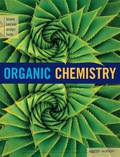
Concept explainers
(a)
Interpretation:
The major product of each of the given reaction has to be drawn.
Concept Introduction:
Oxidation of primary alcohol to

(b)
Interpretation:
The major product of each of the given reaction has to be drawn.
Concept Introduction:
Reaction with

(c)
Interpretation:
The major product of each of the given reaction has to be drawn.
Concept Introduction:
Reaction with
Secondary alcohols may react by

(d)
Interpretation:
The major product of each of the given reaction has to be drawn.
Concept Introduction:
Reaction with
Secondary alcohols may react by

(e)
Interpretation:
The major product of each of the given reaction has to be drawn.
Concept Introduction:
Oxidation of primary alcohol to carboxylic acid: A primary alcohol is oxidized to a carboxylic acid by chromic acid. The mechanism involves initial formation of an alkyl chromate intermediate, followed by reaction with base to remove a proton, generating the carbonyl group of an aldehyde and simultaneously reducing the chromium (VI) to chromium (IV). An initially formed aldehyde adds water, generating an aldehyde hydrate, which is oxidized according to the same mechanism to give the carboxylic acid.

(f)
Interpretation:
The major product of each of the given reaction has to be drawn.
Concept Introduction:
Oxidative cleavage of a glycol:

(g)
Interpretation:
The major product of each of the given reaction has to be drawn.
Concept Introduction:
Oxidative cleavage of a glycol:

(h)
Interpretation:
The major product of each of the given reaction has to be drawn.
Concept Introduction:
Reaction with

(i)
Interpretation:
The major product of each of the given reaction has to be drawn.
Concept Introduction:
Oxidation of primary alcohol to an aldehyde: The oxidation of a primary alcohol to an aldehyde can be carried out using pyridinium chlorochromate (PCC). Because there is no water, the aldehyde does not form the hydrate, and the oxidation reaction stops at the aldehyde stage. Alternatively, Swern or Dess-martin oxidation can be used.

(j)
Interpretation:
The major product of each of the given reaction has to be drawn.
Concept Introduction:
Oxidation of primary alcohol to an aldehyde: The oxidation of a primary alcohol to an aldehyde can be carried out using pyridinium chlorochromate (PCC). Because there is no water, the aldehyde does not form the hydrate, and the oxidation reaction stops at the aldehyde stage. Alternatively, Swern or Dess-martin oxidation can be used.

Trending nowThis is a popular solution!

Chapter 10 Solutions
Organic Chemistry
- In the decomposition reaction in solution B → C, only species C absorbs UV radiation, but neither B nor the solvent absorbs. If we call At the absorbance measured at any time, A0 the absorbance at the beginning of the reaction, and A∞ the absorbance at the end of the reaction, which of the expressions is valid? We assume that Beer's law is fulfilled.arrow_forward> You are trying to decide if there is a single reagent you can add that will make the following synthesis possible without any other major side products: 1. ☑ CI 2. H3O+ O Draw the missing reagent X you think will make this synthesis work in the drawing area below. If there is no reagent that will make your desired product in good yield or without complications, just check the box under the drawing area and leave it blank. Click and drag to start drawing a structure. Explanation Check ? DO 18 Ar B © 2025 McGraw Hill LLC. All Rights Reserved. Terms of Use | Privacy Center | Accessibilityarrow_forwardDon't use ai to answer I will report you answerarrow_forward
- Consider a solution of 0.00304 moles of 4-nitrobenzoic acid (pKa = 3.442) dissolved in 25 mL water and titrated with 0.0991 M NaOH. Calculate the pH at the equivalence pointarrow_forwardWhat is the name of the following compound? SiMe3arrow_forwardK Draw the starting structure that would lead to the major product shown under the provided conditions. Drawing 1. NaNH2 2. PhCH2Br 4 57°F Sunny Q Searcharrow_forward
- 7 Draw the starting alkyl bromide that would produce this alkyne under these conditions. F Drawing 1. NaNH2, A 2. H3O+ £ 4 Temps to rise Tomorrow Q Search H2arrow_forward7 Comment on the general features of the predicted (extremely simplified) ¹H- NMR spectrum of lycopene that is provided below. 00 6 57 PPM 3 2 1 0arrow_forwardIndicate the compound formula: dimethyl iodide (propyl) sulfonium.arrow_forward
 Organic ChemistryChemistryISBN:9781305580350Author:William H. Brown, Brent L. Iverson, Eric Anslyn, Christopher S. FootePublisher:Cengage Learning
Organic ChemistryChemistryISBN:9781305580350Author:William H. Brown, Brent L. Iverson, Eric Anslyn, Christopher S. FootePublisher:Cengage Learning
 Chemistry for Today: General, Organic, and Bioche...ChemistryISBN:9781305960060Author:Spencer L. Seager, Michael R. Slabaugh, Maren S. HansenPublisher:Cengage Learning
Chemistry for Today: General, Organic, and Bioche...ChemistryISBN:9781305960060Author:Spencer L. Seager, Michael R. Slabaugh, Maren S. HansenPublisher:Cengage Learning- Chemistry: Matter and ChangeChemistryISBN:9780078746376Author:Dinah Zike, Laurel Dingrando, Nicholas Hainen, Cheryl WistromPublisher:Glencoe/McGraw-Hill School Pub Co
 Organic And Biological ChemistryChemistryISBN:9781305081079Author:STOKER, H. Stephen (howard Stephen)Publisher:Cengage Learning,
Organic And Biological ChemistryChemistryISBN:9781305081079Author:STOKER, H. Stephen (howard Stephen)Publisher:Cengage Learning, General, Organic, and Biological ChemistryChemistryISBN:9781285853918Author:H. Stephen StokerPublisher:Cengage Learning
General, Organic, and Biological ChemistryChemistryISBN:9781285853918Author:H. Stephen StokerPublisher:Cengage Learning





